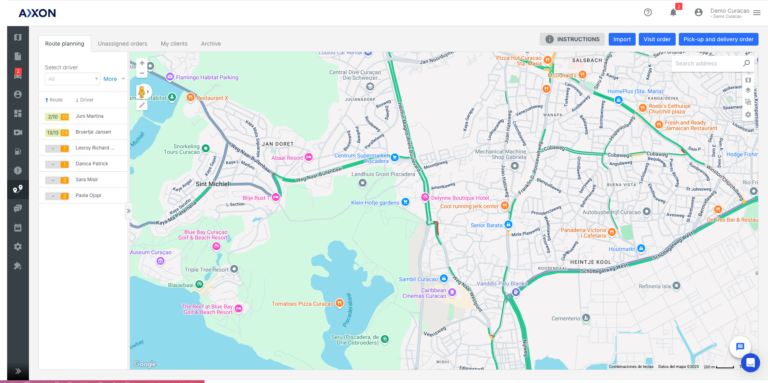Is Your Company Dealing With Vehicle Abuse?
If you've found yourself in this blog, it's likely because you've got a feeling that vehicle abuse might be an issue in your company, and you want to get to the bottom of it. Or, maybe you're just the kind of person who loves to learn about everything and anything.
Whatever your reason, you're in the right place. My goal with this blog is to shine a light on the ins and outs of vehicle abuse. I’m here to help you understand what it is, how to spot it, and most importantly, how to solve it.
So, let’s dive right in.
What is vehicle abuse?
Vehicle abuse involves the improper use of vehicles that leads to damage and decreased vehicle longevity. Misuse encompasses a range of behaviors, such as engaging in off-roading and racing activities that are not intended for the vehicle's design, or neglecting essential maintenance and care. Such actions not only compromise the vehicle's condition but also increase the risk of accidents and incur additional costs for repairs and replacements.
The signs of vehicle abuse:
As a manager in your company, it is crucial to be aware of the various signs indicating vehicle abuse. Here are some key indicators:
- Unauthorized Personal Use: Instances of employees using company vehicles for personal activities, such as an employee driving a significant distance for personal leisure, demonstrate abuse. This misuse can be identified through discrepancies in mileage logs and GPS tracking data.
- Driving Behavior: Behaviors like hard acceleration, harsh braking, and hard turns lead to excessive fuel consumption, increased wear and tear, and higher collision risks. These can also be monitored through vehicle tracking systems.
- Physical Damage from Carelessness: Physical damage to vehicles from actions like jumping curbs or scraping the sides of structures, and the misuse of the interior as a trash can, are clear signs of neglect and abuse.
- Smoking in Vehicles: Despite no-smoking policies, some employees might smoke in company vehicles, leading to a lower resale value due to the tobacco odor and potential burns on upholstery.
- Neglecting Maintenance: Ignoring essential maintenance signals, like the 'check engine' light, or skipping routine services such as oil changes, is a subtle yet serious form of vehicle abuse. This neglect not only endangers driver safety but also leads to higher repair costs and reduced vehicle lifespan, impacting the company's resources and operational efficiency. Regular checks and maintenance education for employees are essential to prevent such issues.
The consequences of vehicle abuse:
Vehicle abuse in a company can lead to a variety of short-term and long-term consequences, impacting working culture, efficiency, and productivity in several ways:
- Financial Impact: Vehicle abuse directly influences the fleet's costs. Abusive behaviors like overloading, harsh driving, or driving for personal use lead to higher repair costs, reduced vehicle lifespan, and most likely excessive employee overtime and high fuel costs.
- Resale Value and Reconditioning Expenses: The resale value of a vehicle is determined by its age, mileage, and overall condition. Vehicle abuse, such as smoking inside the vehicle can lead to reduced resale values due to odors, upholstery damage, and overall poor condition, necessitating unnecessary reconditioning expenses.
- Impact on Company Culture and Policy Enforcement: A lack of accountability or the presence of an entitlement mentality among employees can lead to a culture where vehicle abuse is not taken seriously. This attitude can be particularly problematic when executives or top performers are involved, as there might be a reluctance to enforce policies against them. In the long term, this can erode respect for company assets and policies, leading to a culture where neglect and abuse of company resources are normalized.
- Safety and Liability Risks: Abuse of vehicles can lead to safety hazards. For instance, using the vehicle's interior as a garbage can might impair the driver's ability to operate the vehicle safely. In the long term, such behaviors can increase the risk of accidents, thereby elevating the company's liability and potentially harming its reputation.
- Efficiency and Productivity: In the short term, vehicle abuse can lead to downtime due to repairs and maintenance, affecting operational efficiency. In the long term, the need for frequent replacements due to shortened vehicle lifespans can disrupt schedules and decrease overall productivity.
How to solve vehicle abuse?
Solving and preventing vehicle abuse in a fleet requires a multifaceted approach that includes maintenance, policy enforcement, and the use of technology. Here are some key strategies to implement and consistently maintain:
- Regular Maintenance and Vehicle Upkeep: Ensuring that vehicles and equipment are properly maintained is crucial. Regular maintenance and vehicle inspections diminish the likelihood of abuse. Operators are less likely to misuse well-maintained vehicles.
- Use of GPS Tracking Systems: Implementing a complete GPS tracking system can be effective in preventing various forms of vehicle abuse. These systems can monitor hard driving behaviors (such as hard acceleration, harsh braking, and hard turns), speeding, after-hours use, and unauthorized personal travel. By tracking these activities, you can immediately address and prevent abuse.
- Enforcement of Fleet Policies: Having clear and well-communicated fleet policies is vital. While many companies have such policies, the challenge often lies in enforcement. Consistent application of these policies is necessary. Ensuring that all employees, including new hires, and veterans are aware of these policies and the consequences of not adhering to them is a crucial part of this strategy.
- Consistently keeping up with these solutions involves regular monitoring, training, and policy reviews. Ensuring that all employees are adequately trained in vehicle operation and aware of the importance of maintenance, as well as the consequences of misuse, is essential.
- Regular audits and checks of GPS data and maintenance records can help identify issues early. Fostering a culture of responsibility and respect for company assets goes a long way in preventing abuse.
Click here to see how Brydens Antigua fixed this issue.
“A fleet management system like Axxon helps everyone understand in a simple way that we have to take care of everything at the top so we can all enjoy the profits at the bottom. It’s making people more accountable about their time, what they do, and the assets they are assigned” says Ms. Minors, Managing Director at Brydens
Are you dealing with vehicle abuse?
We know managing a fleet of vehicles is no small task—it's a job that demands your full attention. But don't worry, you're not alone in this. Imagine having the right tools at your fingertips, making your job smoother and more efficient. That's where a system like Axxon steps in, transforming the way you manage your fleet.
Curious to see how Axxon could revolutionize your fleet management? Let's have a chat. In just a quick, under-30-minute call, you'll gain valuable insights and clarity, empowering you to make informed decisions that could redefine your success.
Remember, the road to well-maintained and efficiently managed vehicles begins with a single step—and that step could be a simple phone call away. So, why wait?



